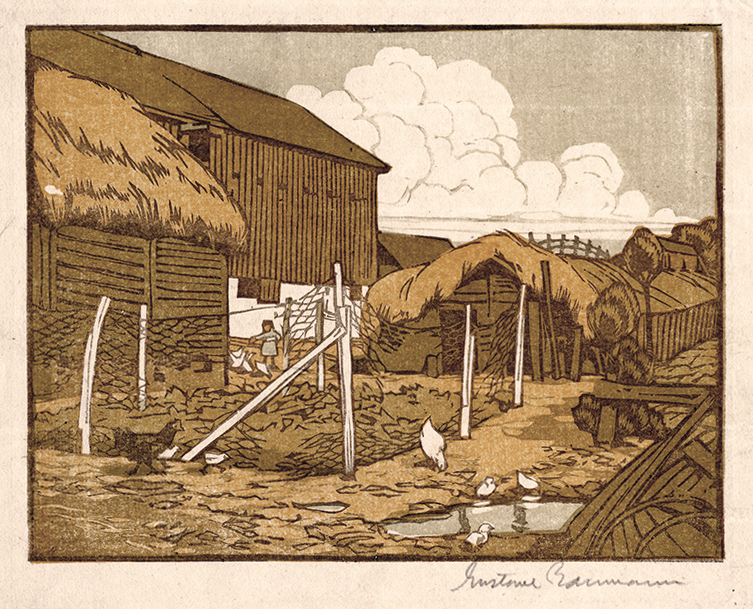Fox Lake Farmyard is a color woodcut from 1908 by American master printmaker Gustave Baumann (1881-1971). This impression is pencil signed and there are seventeen known impressions. It was printed by the artist on ivory laid Japanese paper with water based inks. The image measures 6-7/8 x 8-7/8 inches.
The reference for this work is Chamberlain 7. For an explanation of the printing variations within a very limited edition, we refer you to page 132 of In A Modern Rendering The Color Woodcuts of Gustave Baumann: A Catalogue Raisonné. This impression is illustrated on page 132.
Fox Lake, Illinois is a recreational area near Chicago. Artist members of the Palette and Chisel Club of Chicago had an encampment there and spent their weekends painting and partying in an attempt to forget the dismal routine of commercial work. Of his time in Chicago, Baumann wrote: “I found time to see what other studios produced: there were Eugene Savage, L. ßO. Griffith, Ezra Winters, Leroy Baldridge, Victor Higgins, Walter Ufer, Frank King and Rudolph Ruzicka, all of them like myself doing what was near at hand plus a fling at painting. Over the weekends we all crowded into an accommodation train that took us to our favorite sketching ground around a near-by lake.”
Gustave Baumann was born in Magdeburg, Germany on 27 June 1881. Ten years later his family immigrated to the US, settling in Chicago. In 1896, Baumann began working in the commercial art field while saving money to study in Germany. After returning from Munich in December 1905 where he studied at the Kunstgewerbeschule, Baumann worked again in commercial art to support his family. In 1909, he discovered Brown County, Indiana where life was inexpensive and he could stay for three months. He produced a series of small format color woodcuts featuring the people and places of Brown County and then produced five large format color woodcuts. His woodcuts were accepted by the committee for the 1915 Panama Pacific International Exposition and he won a gold medal in 1916. Baumann headed east to Wyoming, New York in 1917 and taught at a summer school. From there he headed to Provincetown and New York City before returning to set up his studio in Wyoming. The southwest beckoned and he headed west in May 1918, stopping in Taos for the summer and fall. His funds were low and he needed to head back to Chicago but first stopped at the new art museum in Santa Fe to see an exhibition of his woodcuts. The rest, they say, is history.



